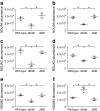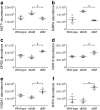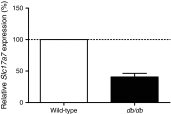Retinal proteome alterations in a mouse model of type 2 diabetes
- PMID: 24078137
- PMCID: PMC3855476
- DOI: 10.1007/s00125-013-3070-2
Retinal proteome alterations in a mouse model of type 2 diabetes
Abstract
Aims/hypothesis: Diabetic retinopathy is a major complication of type 2 diabetes and the leading cause of blindness in adults of working age. Neuronal defects are known to occur early in disease, but the source of this dysfunction is unknown. The aim of this study was to examine differences in the retinal membrane proteome among non-diabetic mice and mouse models of diabetes either with or without metformin treatment.
Methods: Alterations in the retinal membrane proteome of 10-week-old diabetic db/db mice, diabetic db/db mice orally treated with the anti-hyperglycaemic metformin, and congenic wild-type littermates were examined using label-free mass spectrometry. Pathway enrichment analysis was completed with Genomatix and Ingenuity. Alterations in Slc17a7 mRNA and vesicular glutamate transporter 1 (VGLUT1) protein expression were evaluated using real-time quantitative PCR and IMMUNOFLUORESCENCE.
Results: A total of 98 proteins were significantly differentially abundant between db/db and wild-type animals. Pathway enrichment analysis indicated decreases in levels of proteins related to synaptic transmission and cell signalling. Metformin treatment produced 63 differentially abundant proteins compared with untreated db/db mice, of which only 43 proteins were found to occur in both datasets, suggesting that treatment only partially normalises the alterations induced by diabetes. VGLUT1, which is responsible for loading glutamate into synaptic vesicles, was found to be differentially abundant in db/db mice and was not normalised by metformin. The decrease in Slc17a7/VGLUT1 was confirmed by transcriptomic and immunocytochemical analysis.
Conclusions/interpretation: These findings expand the knowledge of the protein changes in diabetic retinopathy and suggest that membrane-associated signalling proteins are susceptible to changes that are partially ameliorated by treatment
Figures








References
Publication types
MeSH terms
Substances
LinkOut - more resources
Full Text Sources
Other Literature Sources
Medical
Molecular Biology Databases
Miscellaneous

